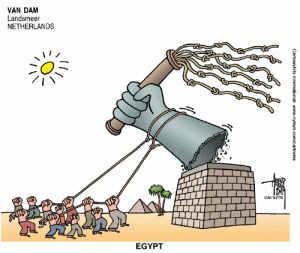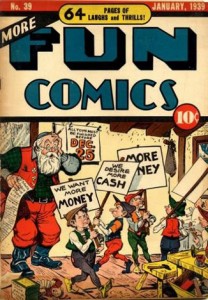Around the end of the 19th century, Progressives celebrated the dawn of rational government. Public policy was to become a social science, and like all sciences it was to be based on quantitative facts. Every aspect of humanity and all possible outcomes would be assigned a numerical value, and then these numbers could be crunched into a thousand equations that would give us perfect governance. No more trial-and-error, no more dishonesty, no more messy emotions getting in the way of sound policy. It was salvation through statistics.
The faith in scientific government may seem absurd today, but much of our public policy is still built around the statistics game. Partly, this is because quantitative measures are generally easy to analyze and explain. If the police report that crime rates rose by 5%, we all understand what that means, and we can draw general conclusions on how to respond. Plus, statistics just seem so damn rational and authoritative, not like those touchy-feely qualitative observations. Decision-makers, bureaucrats, and the public all crave certainty, or at least a close facsimile.
But numbers can be wrong. Or to be more precise, people are lying liars who make up numbers to “prove” whatever they want to prove. In “The Wire,” the public institutions of Baltimore are constantly “juking the stats,” a term referring to various methods by which they falsify statistical data to show progress where there is none, all while the city continues to crumble around them.
While the series creators have plenty of bile for every aspect of Baltimore’s government, none of the institutions are criticized as thoroughly as the Police Department. The Department is portrayed as the apotheosis of public sector dysfunction, and juking the stats is hardwired into its institutional DNA. On several occasions, Commissioner Burrell alters statistical data so as to gloss over the embarrassingly high rates of violent crime. The simplest way that police departments juke the stats is by re-classifying reported crimes as less serious offenses (as an example, aggravated assaults become assaults). The only crime that can’t be downgraded in this manner is homicide, for obvious reasons. This was why Burrell and Rawls were obsessed with the “clearance rate” (the number of murders solved), and homicide detectives concerned about their clearance numbers looked for ways to avoid investigating a (potentially unsolvable) murder, such as by dumping the bodies on another jurisdiction (as with the bodies of the dead prostitutes in season 2).
Baltimore’s school system does not escape scrutiny either, especially during season 4. The public schools are dependent on federal funding, and juking the stats is necessary to show improvement on the standardized tests administered under the federal No Child Left Behind Act (there are unpleasant consequences for a school and its faculty should their students repeatedly under-perform on the tests). As shown on “The Wire,” one common method of improving the scores is to teach to the test. Students are given rote lessons on how to answer specific questions. This can lead to modest improvements in aggregate test scores, but the students are not really learning anything except how to take a test, and so the scores do not accurately measure the students’ mastery of basic academic skills.
For both the police and the schools, much of the problem arises from a conflict of interest: the institutions responsible for reporting the stats are the same institutions that will be judged on them. Few people are willing to admit failure, especially when the consequences include losing your job. Thus, Police Commissioners have every incentive to paint a rosy picture of the city’s crime rates. Nor does auditing by an outside agency solve the problem. An agency tasked with analyzing statistics from the police department would still be dependent on the department for crime data, which means they would likely get the same juked stats. The only alternative would be an independent means of detecting crimes and collating the data, which would be prohibitively expensive, especially for a cash-strapped city such as Baltimore.
Statistics were supposed to give us scientific government, one where the ideal public policy would be crafted in accordance with hard data. This was implausible even in the best case scenario, but when data is falsified, statistics actually grant further authority to the lies of public officials. And without trustworthy stats, how is the public supposed to the judge the performance of public institutions? How are voters supposed to hold their elected officials accountable when we can’t be sure if their policies succeeded or failed miserably?
“The Wire” doesn’t offer any solutions to this dilemma. Rather, it suggests that the nature of our political system, particularly the never-ending electoral cycle, creates irresistible incentives to lie. Mayor Carcetti, for example, initially forces Burrell to resign when he lies one too many times about the crime rates. But when Carcetti begins his gubernatorial campaign, his staff pressures incoming Commissioner Daniels to juke the stats so that Carcetti can claim that crime rates fell during his term as mayor. When Daniels refuses to compromise his morals any further, he’s forced out of office and replaced with a more compliant lackey. The public, by and large, is ignorant of the mayor’s deceit, because the city government controls most of the data collection and analysis.
So how should the public deal with juked stats? One alternative would be to provide more resources to non-governmental organizations that compile and analyze their own data, but NGOs have their own agendas and are equally capable of lying. Or we could abandon our stat-based approach to public policy entirely, and rely more on qualitative observations, such as in-depth news articles. For many reasons, this is highly unlikely to happen, but even if it did, qualitative accounts can also be fraudulent, and they are more often anecdotal rather than reflective of larger social trends.
I was hoping to end my post on an upbeat note. But this is a roundtable on “The Wire,” so maybe it’s appropriate that I throw my hands up in frustration.
_____
Update by Noah: The entire Wire Roundtable is here.





